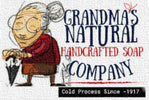Crafting Artisanal Grandma Soap
Grandma made soap back in time.
"Natural Handcrafted Soap Company is dedicated to crafting artisanal soaps the time-honored way, inspired by centuries-old traditions. Our products are made with natural, organic, wild-harvested, and sustainable ingredients, ensuring a gentle, hypoallergenic experience that nourishes your skin and respects the planet."

Cold process soap-making is a traditional method that creates rich, moisturizing bars, often associated with the nostalgic, high-quality soaps Grandma might have made. Here’s a concise overview based on current information:
What is Cold Process Soap? Process: Combines oils or fats (like olive, coconut, or tallow) with lye (sodium hydroxide) dissolved in water. The mixture undergoes saponification, a chemical reaction that turns the ingredients into soap and glycerin over 4-6 weeks of curing.
Characteristics: Produces hard, long-lasting bars with natural glycerin, which hydrates the skin. It allows for creative customization with scents, colors, and textures.
Comparison to Grandma’s Soap: Like the cherished soaps Grandma made, cold process soap relies on time-honored techniques, blending natural oils and fats—often traditional choices like lard or tallow—with lye to create nourishing, glycerin-rich bars. Historically, these soaps were simmered in large pots, but the cold process method skips external heating, using the natural reaction heat instead. Unlike some modern commercial soaps, this approach avoids harmful synthetic detergents, parabens, and sulfates, staying true to the wholesome, skin-loving simplicity of Grandma’s era.
Basic Recipe (Inspired by Traditional Methods)
Lye: Sodium hydroxide (calculate using a lye calculator for precise amounts, typically 5-8% of oil weight).
Liquid: Distilled water or milk (2-3 times the lye weight).
Optional: Essential oils (like lavender or peppermint, 1-3% of oil weight), herbs, or natural colorants.
Why It’s Like Grandma’s Soap Natural Ingredients: Uses simple, often locally sourced oils and no synthetic detergents, mimicking traditional recipes.
Handcrafted: Each batch is unique, with a rustic charm reminiscent of pot-made soaps.
Nourishing: Retains glycerin, unlike many commercial soaps, for a creamy lather and gentle cleanse.
Tips for Authenticity: tallow or lard for a traditional feel, as these were common in older recipes.
Incorporate milk (like goat’s milk) or honey for creaminess, as seen in some vintage soaps.
Stick to simple molds (wooden or silicone) and avoid over-complicating with modern additives.
Resources Calculators: SoapCalc.net or Soapee.com for precise measurements.
Supplies: Local craft stores or online retailers
Safety: Always handle lye with care; follow guidelines from sources on Google.



 What makes Natural Handcrafted Soap different from regular soap?
What makes Natural Handcrafted Soap different from regular soap?
0 comments